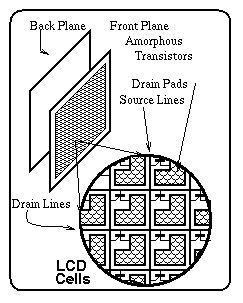 2.2. Flat Panel Displays.
2.2. Flat Panel Displays.  2.2. Flat Panel Displays.
2.2. Flat Panel Displays. Flat panel displays are finding use in electronic data processing equipment and graphics because they offer reduced size, weight and power consumption. The technologies include flat CRTs, electro-luminescence plasma (and vacuum fluorescence) displays, liquid crystals (bistable and conventional) and LED displays.
Only liquid crystal technologies appear to challenge the conventional CRT in terms of price and/or performance. The CRT is very cheap!
The CRT is typically heavy because of the thickness and composition of the glass. It operates under a vacuum in a glass envelope that must be of sufficient thickness to withstand atmospheric pressure. The face plate is also made of high density lead glass to absorb high energy radiation. The CRT has a high aspect ratio (depth to width in this case). This is necessitated by the electron beam in the neck and the deflection system, which causes the electron beam to scan across the face of the tube, activating phosphor materials to produce an image one dot at a time.
Flat panel displays have electro-optical material sandwiched between the front face with transparent electrodes and a back plate with electrodes orthogonal to those of the front plate.
Matrix of small LED's with each individual led capable of being on-off. Not feasible at present.
The electron beam in a flat CRT is initially projected parallel to the screen and is then bent through 90 degrees to impinge on the phosphor screen. An opposing transparent electrode is used for focusing.
The electro-luminescent display is constructed with a series of thin-film deposited layers on a glass plate. The electro-luminescent layer is sandwiched between insulator outer layers and conductive electrodes. A bias of approximately 200 volts is applied to the device. An orange-yellow visible light is emitted when an additional voltage of 30 volts is applied to the electro-luminescent material.
Very high quality is obtainable but the density of pixel elements is not high enough for good graphics work as yet.
The plasma display sandwiches a mixture containing neon gas between two glass plates. The inner surface of the glass carry the electrodes. Thin-film insulator is coated on the transparent conductor electrodes to provide a capacitive storage or memory. Application of a voltage above a certain threshold begins an ionization of the gas mixture, which emits a visible orange light.
Advantages are simple construction, reliable, good contrast and brightness. Disadvantages are high cost orange colour and need for high voltage. Resolution is not yet good enough for cheap graphics.
The conventional LCD consists of liquid crystal material between two glass plates. Transparent conductive lines are configured on the inner surfaces of the plates. A transparent polarizer is attached to the outer surface of the top plate and a polarizer reflector combination is attached to the outer surface of the bottom plate. The two polarizers are oriented at 90 degrees to each other. The inner surface of the cell is treated with aligning agents so that the molecules are parallel to the glass surface and form a 90 degree spiral staircase.
Light passed through the front glass is polarized and receives a ninety degree twist and exits in the same plane as it entered. If a voltage is applied across the device, the liquid crystal molecules line up perpendicular to the glass and do not give the 90 degree twist; thus the polarizers would block the light and give a dark colour.
The construction of the bistable liquid display is basically a simplification of the conventional display . Polarizers are eliminated and a dichroic dye is used instead. Also eliminated is the preparation of the inner surfaces of the glass plates. In addition the row electrodes also serve as reflectors internal to the device.
`The dichroic dye is co-operatively oriented parallel to the long axis of the liquid crystal molecules. When these molecules are perpendicular to the surface of the glass, the background electrode reflector appears across the entire display. When molecules are oriented randomly, in parallel, or in any non- perpendicular manner to the glass, the dichroic dye appears black; thus black characters can be generated on a silver background.`
Liquid crystal displays of this type are now becoming very
attractive for dislaying graphics. The cost is reasonable and the
resolution quite high. Couple this with weight and size and the
LCD is very impressive. Current resolution is approximately
600x400. See Figure 2.8 for typical layout for a graphics LCD
screen.

Fig. 2.8 : LCD for Graphics












